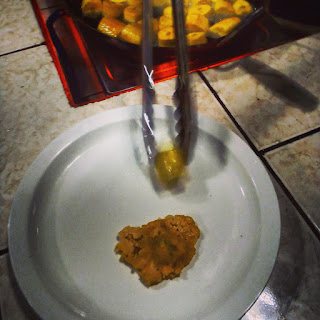Spending a month in
Sarapiqui and living with a host family taught me a great deal about Costa Rica and
its culture. I was pretty isolated in Chilamate, without doing much sightseeing, but that gave me a chance to really experience the life of a Tico. The name Tico, a general term for a Costa Rican (I thought this might just be a term foreigners call Costa Ricans, but I was actually corrected by my host mom to just say 'Ticos'), comes from the diminutive in the Spanish language that Ticos tend to add to most words. For example, the word gato means cat in Spanish, but gatito means little cat, or kitten. Ticos tend to add the diminutive to words like ahora, which means now.
"Hola, when is the bus coming?"
"Ahorita."
"What? Ohh, you're speaking Tico Spanish."
Costa Rica means 'Rich Coast' in Spanish, named by Christopher Colombus himself after he had a brief stopover in 1502. Of course, Costa Rica had native inhabitants long before Colombus arrived, (clad in gold jewelry, which was why he called it 'rich') but once it was put on Spain's map it wasn't left alone for much longer. Conquistadors arrived in pursuit of the gold that drove them in hordes across the Atlantic, but despite its promising name, Costa Rica yielded very little gold, and instead turned into a killing ground for the natives. Most of those that the Spaniards did not murder died of smallpox, leaving only 1 percent of today's population of indigenous heritage. The rest of the population is of Spanish descent, with another small percentage of Africans, after the Spanish brought them over as plantation slaves.
After the initial bloodshed, Costa Rica has had a pretty turbulent-free history, due to its lack of gold and silver. There was a brief civil war between the four main emerging republics in the Central Valley, with two of them wanting to be a part of Mexico and two wanting to be independent, which resulted in a republican victory and a sovereign state in 1823. Since then, aside from a few skirmishes, it has become one of the more prosperous Central American countries, financed in the late nineteenth century as one of the original 'Banana Republics', under the United Fruit Company. This monopoly led to the building of railways to transport primarily bananas to the coasts, which led to increased trade and prosper. Today bananas remain one of Costa Rica's top exports, along with pineapple and coffee beans.
Their national dish is gallo pinto, which is black beans, rice, and onion fried together. My host mom made this for breakfast every morning, along with freshly filtered coffee, and sometimes half an avocado or a fried egg. Other typical foods include arroz con pollo, or rice with chicken (along with other vegetables), empanadas (fried deliciousness stuffed with more deliciousness), and various dishes made with potatoes, yucca (cassava) or plantains, which are a larger, more starchy version of bananas. Cilantro and lime aren't unusual flavors to find in most Tico dishes. And of course, there is always an abundance of fresh tropical fruits such as papaya, pineapple, mango, and bananas available. Needless to say, I ate well in Costa Rica.
Today Costa Rica is very Westernized, and a mecca for tourists seeking mostly nature-oriented vacations, thanks to its status as "one of the 20 countries with the highest biodiversity in the world." (Wikipedia) I just learned that the new Will Smith movie "After Earth" was filmed primarily in Costa Rica, some of it in Sarapiqui. To the Ticos who live in 'la selva,' or 'jungle' climates, tropical animals, insects, birds, and bugs are just another part of their everyday life. Machetes are not uncommon for whacking down persistent weeds, plants, or just to have on hand for a random snake encounter. I remember my first weekend in Sarapiqui I went for a walk and encountered a bright green and black poison arrow dart frog. I was immediately taken back to my childhood when my brother and I had an 'I Spy' rainforest book, where we had to look for the very same dart frog that was jumping right in front of me. I most definitely was not in Minnesota anymore.
To give you more of an idea of living in Chilamate, here are some pictures to help illustrate your life if you were a Tico living in 'la selva.'
For starters, you might see this view on a hike in a nearby nature reserve...
Or you might run into one of these poison arrow dart frogs on the same hike.
You might eat afternoon snacks like this fresh off the tree...
Or you might be eating patacones, or fried plantain chips, with fresh guacamole.
You might have this as your weekend swimming pool...
You might see this when the sun sets over your back yard...
Or you might have this as your front yard.
You might see an iguana hanging out on a nearby tree...
Or one of these guys when you look out of your window at work...
Or a Golden Orb spider making one of its elaborate webs.
And this might be on the side of the road.
You might cook your food in a wood-fired oven like this...
Or you might see one of these on your walk home.
But most importantly, you might make friends with wonderful, warm, loving, and caring Ticos like these...and then you would be a very, very lucky person.
Pura Vida.














No comments:
Post a Comment